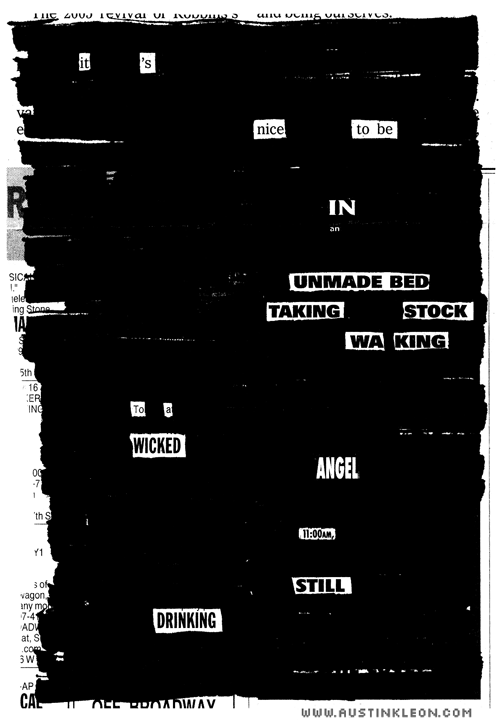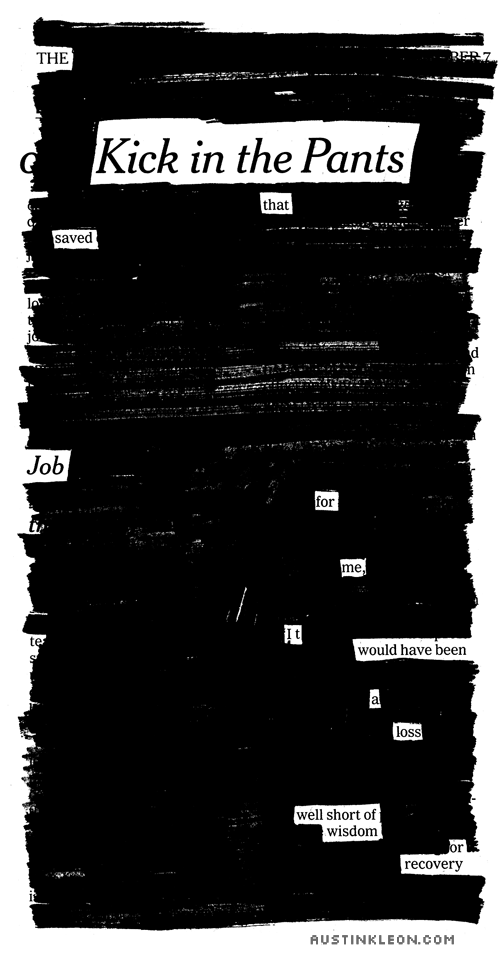
Search Results for: blackout poem
SO MANY PLACES
IN AN UNMADE BED
SAVING UP FOR WHEN THIS IS ALL OVER
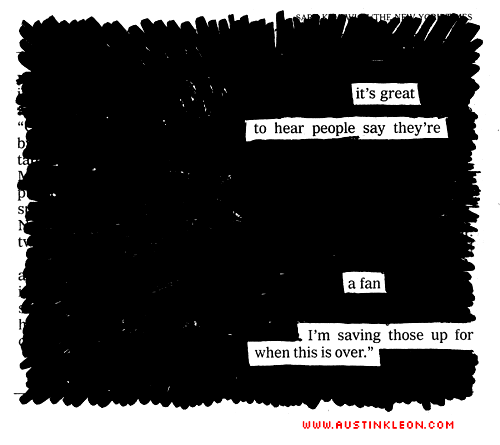
Making art is a lonely business. Hell, being alive is a lonely business.
I have been swimming in tweets and nice e-mails from people discovering my work via the 20×200 prints. It’s pretty wonderful. And disorienting. And a major high.
But it will taper off. And next week I will have a dark day when I want to quit, when I wonder why the heck I even bother with this stuff.
That’s why I attach a Gmail label to every nice e-mail I get. (Trollish e-mails get deleted.) When those dark days roll around and I need a boost, I just click on that label and read through a couple.
Then I get back to work.
Try it: instead of keeping a rejection file, keep a praise file. For when you need the lift.
HOW?
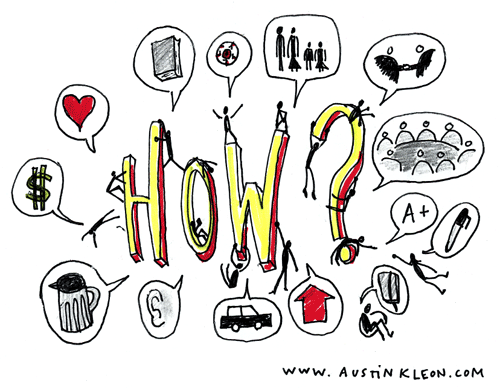
Creative-writing programs are designed on the theory that students who have never published a poem can teach other students who have never published a poem how to write a publishable poem.—Louis Menand, “Show or Tell: Should creative writing be taught?“
For me, the question isn’t should, it’s how.
How should creative writing be taught?
In The 3 A.M Epiphany, Brian Kitely writes that his approach is to make the creative writing workshop a workshop in the sense of an artist or carpenter: “a light, airy room full of tools and raw materials where most of the work is hands-on.”
The standard American workshop is a lazy construction. The teacher asks students to bring in stories or poems to class, sometimes copied and handed out ahead of time, sometimes not. The class and its final arbiter (usually the teacher) judge the merits of the story or poem. Few ask the question, “Where does a story come from?” The standard American workshop presumes that you cannot teach creativity or instincts or beginnings. It takes what it can once the process has already been started. Most writing teachers say, “Okay, bring in a story and we’ll take it apart and put it back together again.” I say, “Let’s see what we can do to find some stories.” The average workshop is often a profoundly conservative force in fiction writers’ lives, encouraging the simplifying and routinizing of stories….I use exercises in my workshops to derange student stories, to find new possibilities, to foster strangeness and irregularity, as much as to encourage revision and cleaning up after yourself, and I don’t worry much about success or failure.
I don’t really like doing exercises, I like playing games. My own philosophy is: “if writing isn’t a joy for the writer to write, it won’t be a joy for the reader to read.” So, I’ve spent the majority of my recent writing life trying to turn writing into a game—to push it explicitly towards play. (Like, ahem, using newspapers and markers to make poems…)
[Note: for more on writing as a game, read up on OuLiPo.]
No one has influenced my thinking about this more than the writer and cartoonist Lynda Barry, who I met in 2006. She has dedicated her to most-recent work to the question, “Where do stories come from?”, first in her book, One! Hundred! Demons!, where she used a japanese sumi-e brush to draw her “demons,” and second in her amazing collage-art/comix-memoir/writing textbook, What It is.
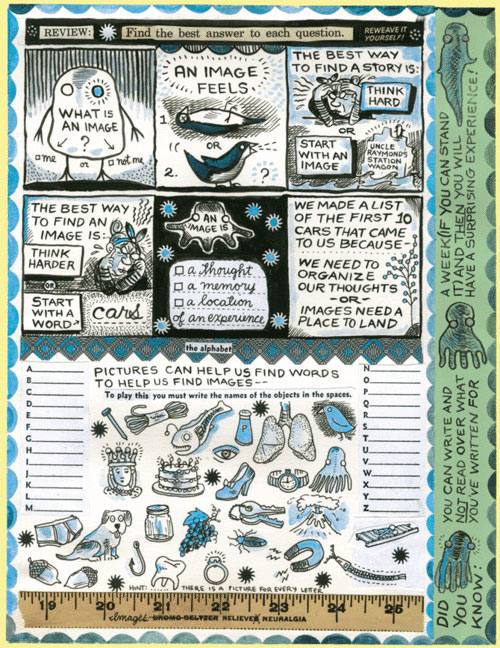
a page from What It Is
From an interview with the Comics Reporter:
What It Is is based on something I learned from my teacher, Marilyn Frasca, at the Evergreen State College in Olympia, Wash. I studied with her for two years in the late 1970s. Her idea seemed to be that everything we call art, whether it’s music or dance or writing or painting, anything we call art is a container for something she called an image. And she believed that once you understood what an image is, then the form you give it is up to you.
The question “What is an Image?” has guided all of my work for over 30 years. Because of what I learned from Marilyn, there isn’t much of a difference in the experience of painting a picture, writing a novel, making a comic strip, reading a poem or listening to a song. The containers are different, but the lively thing in the center is what I’m interested in.
Can you teach creativity? Maybe not, but you can teach people what the energy flow of creating something feels like (hint: it’s no different from how you felt smashing GI Joes together in the driveway), and once you’ve felt that energy, you can set up processes to help you tap into that energy.
Once you know how to drink from that tap, then it’s only a matter of spending a bunch of time with a paintbrush, or a guitar, or an arc welder.
And to get back to the Kitely quote, “don’t worry much about success or failure.” This is a really important point. There’s a place for creating for writing for the sheer joy of writing, and there’s a place for figuring out whether it’s any good or not. In Lynda’s workshop, there is nothing but encouragement. No place for criticism.
My own stance is that art isn’t made by committee. If you want to know whether your stuff is any good, get a big bunch of readers (not just teachers [people paid to read your writing] or students [people paying to read your writing]), and see what happens. The way I did this was by starting a blog—by putting my stuff up for free on the internet.
The key ingredient in all this is time. You need time to get good, and you need time to build a readership.
So if it’s going to take time, how do you feed and clothe yourself after college?
The answer: get a day job and keep it.
I just finished Hugh MacLeod‘s great new book, Ignore Everybody. Hugh has said the book is “advice I wish I had when I was in my early 20s that I learned the hard way after many years. I had just finished college and I had a creative bug, but I had no way to make a living doing it.” It sprung from his piece “How To Be Creative,” which was a big deal to me when I found it a year or so ago, specifically for his “Sex and Cash Theory.”
The creative person basically has two kinds of jobs: One is the sexy, creative kind. Second is the kind that pays the bills. Sometimes the task in hand covers both bases, but not often. This tense duality will always play center stage. It will never be transcended.
Once you let go of the idea of making your money primarily by being an artist, you’re set free. You can make what you want. Get a day job, work 9-5, and squirrel a few hours each day away for your writing, drawing, whatever. Start a blog, so you have an outlet. Once your art is making more money than your day job, you can quit (I sure as heck still work my 9-5…)
My big question, which I’ve asked of many writers, and many have been unable to answer, is: how can you be a decent family man and also be an artist?
Many of our favorite writers/artists weren’t so great as human beings. They couldn’t keep their marriages together, they neglected their kids, they lost their friends—all in sacrifice to their art.
The world needs more great human beings. It doesn’t necessarily need more artists.
I haven’t found many great books on balancing art and family. I have a sneaking suspicion that any such books have been written by women. (Maybe you can suggest a couple?)
The one book I have read that’s helped me out is Bruce Holland Rogers’ Word Work. There are three great chapters on relationships in that book: “Writers and Lovers,” “Writers Loving Writers,” and “Writers Loving Non-Writers.”
So anyways, when it comes to ways to teach writing and teaching folks how to be writers, you could do a lot worse than to buy these books:
- Lynda Barry, What It is
- Hugh Macleod, Ignore Everybody
- Bruce Holland Rogers, Word Work
- Brian Kitely, The 3 A.M Epiphany
Let me know what you think and please list your favorite writing/creativity books in the comments!
- ← Newer posts
- 1
- …
- 56
- 57
- 58
- 59
- 60
- …
- 66
- Older posts→


